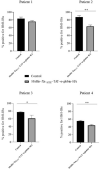PTD-mediated delivery of α-globin chain into Κ-562 erythroleukemia cells and α-thalassemic (HBH) patients' RBCs ex vivo in the frame of Protein Replacement Therapy
- PMID: 34284828
- PMCID: PMC8290593
- DOI: 10.1186/s40709-021-00148-3
PTD-mediated delivery of α-globin chain into Κ-562 erythroleukemia cells and α-thalassemic (HBH) patients' RBCs ex vivo in the frame of Protein Replacement Therapy
Abstract
Background: α-Thalassemia, a congenital hemoglobinopathy, is characterized by deficiency and/or reduced levels of α-globin chains in serious forms of α-thalassemia (HbH disease/Hb Bart's). This research work deals with a Protein Replacement Therapy approach in order to manage α-thalassemia manifestations, caused by the excess of β-globin chain into HbH RBCs. The main goal was to produce the recombinant human α-globin chain in fusion with TAT, a Protein Transduction Domain, to ex vivo deliver it into HbH patients RBCs, to replace the endogenous missing α-globin chain.
Results: Cloning of the α-globin coding sequence, fused to the nucleotide sequence of TAT peptide was conducted and the human recombinant fusion proteins, 10xHis-XaSITE-α-globin-HA and 10xHis-XaSITE-TAT-α-globin-HA were produced. The ability of human recombinant 10xHis-XaSITE-α-globin-HA to interact in vitro with the previously produced 10xHis-XaSITE-TAT-β-globin-HA and form α-/β-globin heterodimers, was assessed and confirmed by size exclusion chromatography. The recombinant 10xHis-XaSITE-TAT-α-globin-HA was successfully delivered into human proerythroid K-562 cells, during the preliminary transduction evaluation experiments. Finally, the recombinant, TAT-fused α-globin was successfully transduced into RBCs, derived from HbH patients and reduced the formation of HbH-Inclusion Bodies, known to contain harmful β4-globin chain tetramers.
Conclusions: Our data confirm the successful ex vivo transduction of recombinant α-globin chains in HbH RBCs to replace the missing a-globin chain and reduce the HbH-inclusion bodies, seen in α-thalassemias. These findings broaden the possibility of applying a Protein Replacement Therapy approach to module sever forms of α-thalassemia, using recombinant α-globin chains, through PTD technology.
Keywords: HbH thalassemic patients’ RBCs; Intracellular transduction via PTD; LC − MS/MS analysis; Size exclusion chromatography; TAT-α-globin.
© 2021. The Author(s).
Conflict of interest statement
All authors declare no conflict of interests.
Figures










Similar articles
-
Production and Transduction of a Human Recombinant β-Globin Chain into Proerythroid K-562 Cells To Replace Missing Endogenous β-Globin.Mol Pharm. 2018 Dec 3;15(12):5665-5677. doi: 10.1021/acs.molpharmaceut.8b00857. Epub 2018 Nov 12. Mol Pharm. 2018. PMID: 30375878
-
Laboratory Evaluation of Alpha Thalassemia.2024 Feb 9. In: StatPearls [Internet]. Treasure Island (FL): StatPearls Publishing; 2025 Jan–. 2024 Feb 9. In: StatPearls [Internet]. Treasure Island (FL): StatPearls Publishing; 2025 Jan–. PMID: 36508547 Free Books & Documents.
-
In vivo biodistribution study of TAT-L-Sco2 fusion protein, developed as protein therapeutic for mitochondrial disorders attributed to SCO2 mutations.Mol Genet Metab Rep. 2020 Dec 8;25:100683. doi: 10.1016/j.ymgmr.2020.100683. eCollection 2020 Dec. Mol Genet Metab Rep. 2020. PMID: 33318931 Free PMC article.
-
Oxidative denaturation of red blood cells in thalassemia.Semin Hematol. 1990 Jan;27(1):70-82. Semin Hematol. 1990. PMID: 2405497 Review.
-
Laboratory investigation of hemoglobinopathies and thalassemias: review and update.Clin Chem. 2000 Aug;46(8 Pt 2):1284-90. Clin Chem. 2000. PMID: 10926923 Review.
Cited by
-
An Innovative PTD-IVT-mRNA Delivery Platform for CAR Immunotherapy of ErbB(+) Solid Tumor Neoplastic Cells.Biomedicines. 2022 Nov 10;10(11):2885. doi: 10.3390/biomedicines10112885. Biomedicines. 2022. PMID: 36359405 Free PMC article.
-
Recruiting In Vitro Transcribed mRNA against Cancer Immunotherapy: A Contemporary Appraisal of the Current Landscape.Curr Issues Mol Biol. 2023 Nov 16;45(11):9181-9214. doi: 10.3390/cimb45110576. Curr Issues Mol Biol. 2023. PMID: 37998753 Free PMC article. Review.
-
Hotspots and status of Fetal Alpha-Thalassemia from 2009 to 2023: a bibliometric analysis.Front Pediatr. 2024 Dec 11;12:1467760. doi: 10.3389/fped.2024.1467760. eCollection 2024. Front Pediatr. 2024. PMID: 39726529 Free PMC article.
-
Beyond transfusions and transplants: genomic innovations rewriting the narrative of thalassemia.Ann Hematol. 2025 Aug 16. doi: 10.1007/s00277-025-06548-y. Online ahead of print. Ann Hematol. 2025. PMID: 40817923 Review.
References
Grants and funding
LinkOut - more resources
Full Text Sources

